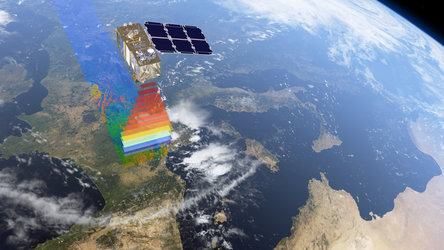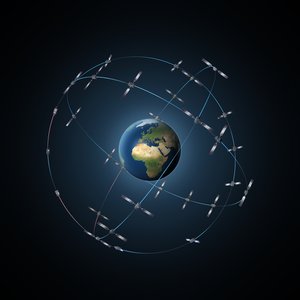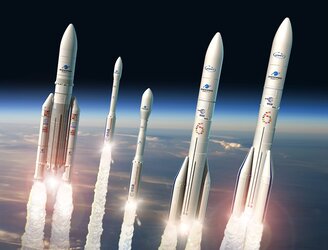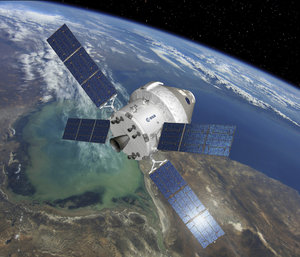Cross-cutting initiatives
Cross-cutting initiatives and concepts that are not covered by specific programmes strengthen interdisciplinary approaches, exchange and coordination of R&D between all programmes, broaden interactions and links between upstream and downstream, and move towards a leaner, highly responsive, diverse and proactive Space 4.0 organisation.
Addressing societal challenges has been and continues to be one of the ESA’s highest priorities. Many of the existing and proposed programmes or activities serve this objective with specific and unique contributions. Overall coordination is to be ensured at corporate level, in particular to support information towards and from the external world and the users concerned to provide the service required exactly when it is required.
Among the top priority societal challenges are climate change, food security, access to clean water, sustainable development (in particular to alleviate need for migration) and the Arctic. For some of these, like food security and access to clean water, the effects are most severe outside Europe, but European citizens will be heavily impacted by their consequences. Energy, maritime activities or health are also considered. Disaster management and migration in particular have taught us that proactivity, high responsiveness and the unique contribution of diverse organisations can tilt the balance towards positive outcomes when addressing global challenges of great proportions.
Making better use of data, sharing knowhow, preparing future generations.
ESA has long and extensive experience of Public-Private Partnerships (PPPs). The development of new markets for space products and services in increasingly competitive fields in all areas of space activities, with the exception of science, demands synergy between different systems and applications, both space and non-space.
A special coordination is being put in place among ESA’s Directorates in the different programme areas with the following aims:
- to adequately address the increasingly more frequent partnerships between the public and the private sectors;
- to maximise programmatic synergies and use of assets – resources and competences – available, and
- to foster and drive cross-fertilisation, including best use of lessons learned.
Space Safety/Space Traffic Management
The defence of planet Earth and the protection and preservation of the global space infrastructure and the capabilities available to citizens relying on Earth-orbiting satellites are a high priority for Europe.
A number of initiatives are currently undertaken within ESA to address these issues. These initiatives need to be continued and enhanced in order to achieve the required effect on long-term sustainability of spaceflight and resources as well as planetary defence, notably through operational space-weather monitoring, active space-debris removal, asteroid deflection capabilities and improved surveillance and tracking systems.
To allow Europe to fully benefit from all the activities being undertaken toward that objective, it is proposed to group those initiatives and programmes that would benefit from more multidisciplinary and concerted efforts, thereby also better integrating space in European society and the economy.
Under the name of Space Safety/Space Traffic Management, those programmes and projects that contribute to the following would be aggregated:
- building and maintaining a European network for space situational awareness (to gather, process and relay space weather and in-orbit traffic data, including information relating to solar activity, asteroids, comets and man-made space objects of all sizes, and based on collaboration within and outside ESA Member States);
- building the necessary ground and space assets to provide services including early warning of potential hazards;
- acquiring capabilities to interact with the space environment for remediation actions on man-made objects and proactive planetary defence (e.g. asteroid deflection, controlled deorbiting).
Specifically these programmes and projects are today: Space Situational Awareness, Asteroid Impact Mission and e.Deorbit/Tug.
Opportunity Missions
Opportunity Missions, which encompass a multitude of different aspects and configurations – from small satellites with single payloads, to lower cost missions, to satellites based on miniaturised components, flown as single platforms or as constellations – are being developed further. The aim is to develop standardised, plug-and-play, and more fully autonomous satellites offering flexible and sustainable (affordable and responding to all the requirements of sustainable uses of space, including clean space) ways to perform focused missions, technology development and demonstrations, competence building or the provision of dedicated services.
A new initiative has been launched for Opportunity Missions. ESA’s General Support Technology Programme will be the incubator/host for future technology demonstration missions, whereas ARTES Pioneer is proposed to be a host for in-orbit demonstration /validation of innovative services.
In addition, Opportunity Missions are included in the following programme proposals: EOEP-5 (SAOCOM-CS), EarthWatch (Altius), ARTES Partner Programmes (Pioneer), and GSTP (IOD, Proba, CubeSat and AIM). EarthWatch provides a generic opportunity for small missions within a PPP context.
Furthermore, a programme proposal is under elaboration putting forward activities to provide timely and competitive launch service solutions with ESA-developed launchers (Vega/Vega-C, Ariane 6) cofounded by users and, possibly, by the European Commission for small satellites to European public sector organisations and institutions.












